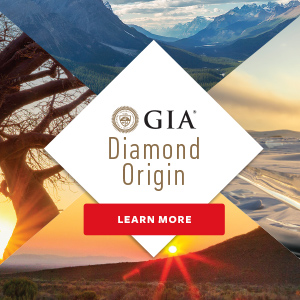
Contemporary consumers are increasingly concerned with knowing the impact created by the people and places that supply their goods. In the jewelry industry, this means knowing where gems come from and how mining affects the people involved. The Gemological Institute of America created its Diamond Origin Report to help consumers understand the good that diamonds do in the countries that produce them.
But how do we know where a diamond comes from?
Scientific Matching of Rough to Polished Gem
GIA first takes in a diamond rough from a specified country. Scientists then document the diamond rough’s unique characteristics—including spectroscopy, growth structure, inclusions and dimensions—caused by the diamond’s growth conditions within the earth. Once these characteristics are recorded, the diamond is sent off to be cut and polished. After being cut, the gems are returned to GIA, where each stone is carefully examined to see if it matches the characteristics of the original rough. Grading reports are then issued for each diamond, listing its country of origin as well as its 4Cs quality assessment. A GIA report number is inscribed on each diamond to identify it with its report wherever it goes.
Diamonds Do Good for Miners and Consumers
When customers buy diamonds of known origin, they contribute to the countries that produce them. Taxes on and support from diamond companies build schools, hospitals, and roads, and create tens of thousands of jobs. Charitable efforts by the diamond industry touch virtually every part of life, including protecting wildlife and environmentally fragile areas. In Botswana, for example, the diamond industry makes up roughly one-quarter of the country’s gross domestic product, and revenue from diamonds helps combat HIV and AIDS. In Canada, certain indigenous tribes receive royalties from local diamond mines and are given preference in contracts. In South Africa, a mining company established the Venetia Limpopo Nature Reserve, which helps protect lions, elephants, leopards, and African wild dogs.
GIA currently works with mining companies in South Africa, Russia, Botswana, and Canada to provide Diamond Origin Reports for qualified diamonds. More countries are being added to this list as consumer desire for knowing diamond origin increases. These selected countries are known for producing diamonds responsibly and for being mindful of sustainability and equitable pay for workers.
The GIA Diamond Origin Report tells the story—of a diamond’s billion-year journey from deep within the earth to the hands of today’s customers. It also tells the story of the people in the country who help uncover diamonds as well as the greater story of the economic advancements made possible by the local diamond industry. To help retailers narrate the journey of the diamonds they offer, GIA’s website and the GIA Origin App display full-color digital images of Diamond Origin Report diamonds in both their rough and polished states. The Retailer Support Program also provides many free-to-download assets and point-of-sale tools. When retailers offer diamonds with origin reports, they satisfy consumer demand for transparency and give consumers the knowledge they need to wear their jewelry with pride.